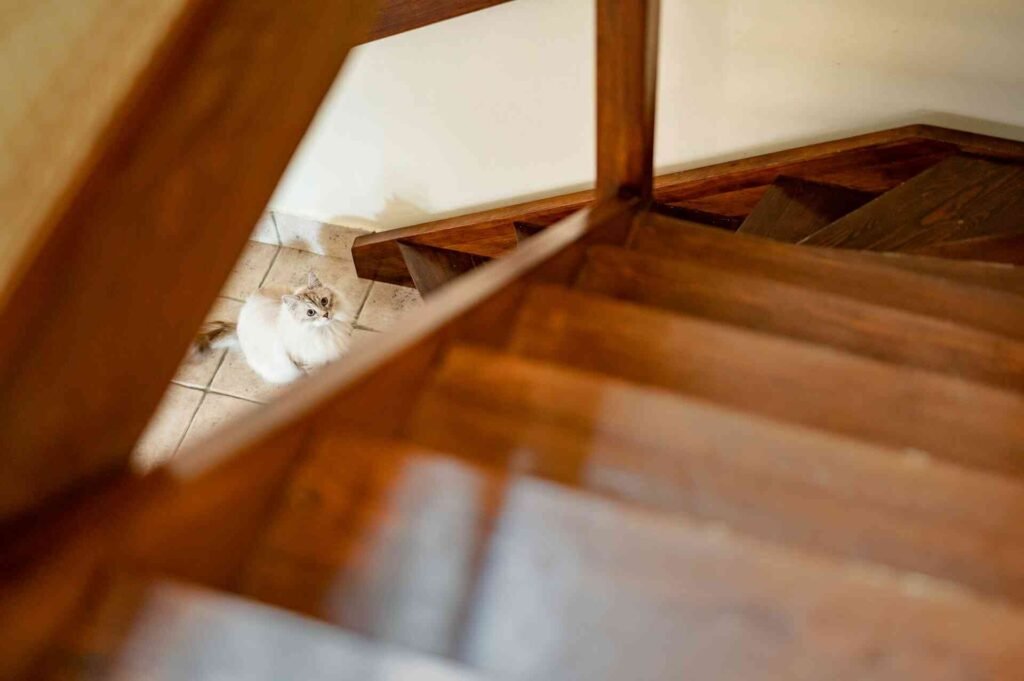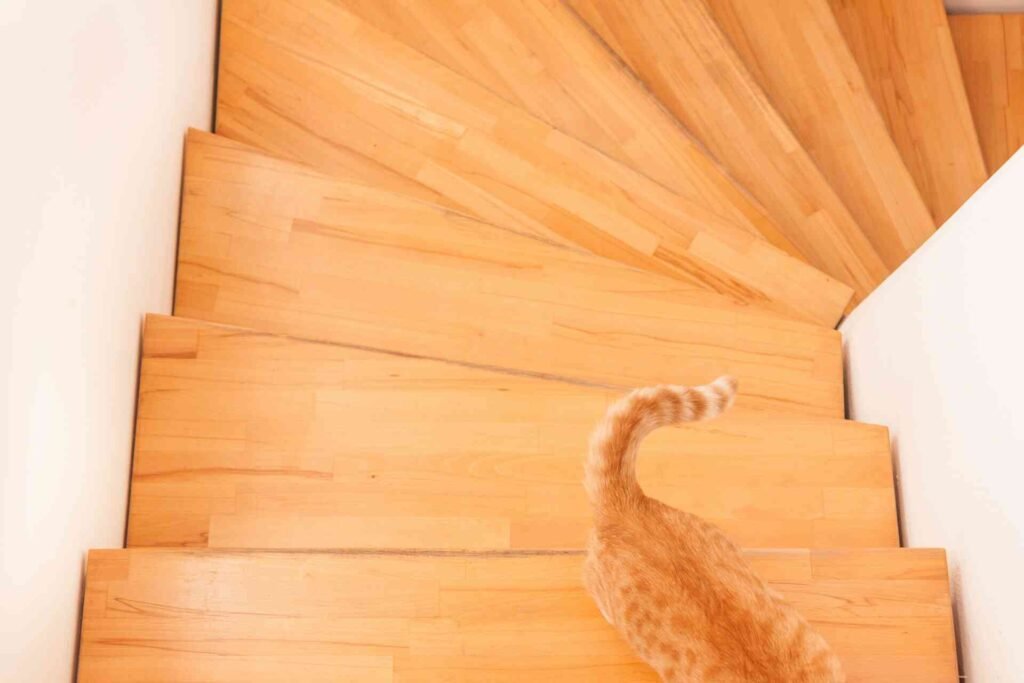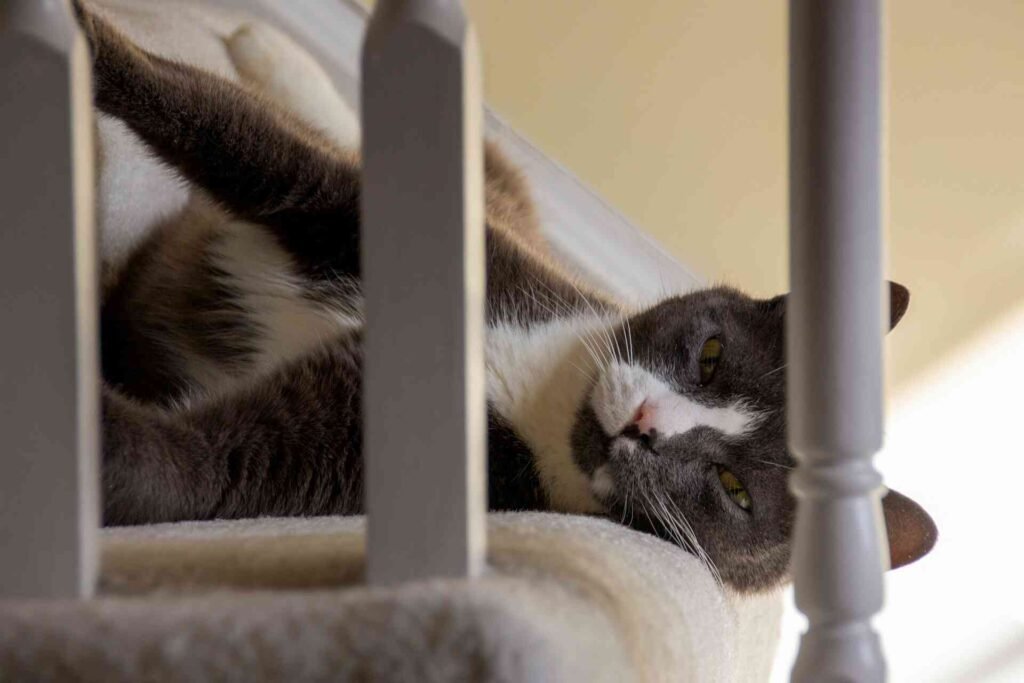You’ve just finished vacuuming the upstairs bedrooms, organizing guest spaces, or setting up a quiet home office, only to find your feline friend has already claimed the freshly made bed as their new kingdom. Sound familiar? You’re not alone in wondering how to keep cats from going upstairs while still maintaining a harmonious home environment.
Whether you’re dealing with allergies, trying to establish boundaries, or simply want to protect certain areas of your home, creating effective barriers doesn’t have to turn into a daily battle of wills with your clever cat. The key lies in understanding why cats are drawn upstairs in the first place and implementing solutions that work with their natural instincts rather than against them.

Why Cats Are Naturally Drawn to Higher Ground
Before diving into solutions, it’s worth understanding what makes the upstairs so appealing to our feline companions. Cats are natural climbers with an evolutionary drive to seek elevated spaces. These higher vantage points offer security, warmth, and the perfect spot for surveillance, essentially everything a cat desires in their ideal territory.
The upstairs often provides quieter spaces away from household hustle and bustle, cozy bedrooms with soft furnishings, and those irresistible sunny windowsills. Cats spend 12-16 hours sleeping daily, and they’re naturally drawn to the most comfortable spots available, which often happen to be upstairs.
Physical Barriers: Your First Line of Defense
When it comes to immediate results, physical barriers offer the most straightforward approach to preventing upstairs access. These solutions provide clear, visual boundaries that cats can easily understand while giving you peace of mind that the restriction is consistently enforced.
Pet Gates: The Most Popular Solution
A gate to stop cats going upstairs remains the most straightforward approach, though not all gates are created equal. Traditional baby gates often prove insufficient for agile cats who can easily leap over or squeeze through standard designs. Look for gates specifically designed for cats, featuring:
- Heights of at least 36-42 inches
- Narrow spacing between bars (no more than 2 inches)
- Secure mounting systems that cats can’t dislodge
- Optional extensions for wider staircases
The beauty of gates lies in their immediate effectiveness and visual clarity, your cat quickly understands the boundary you’ve established.
Alternative Physical Barriers
When gates aren’t practical, consider these creative alternatives:
Temporary barriers work well during training phases. Large pieces of cardboard, plexiglass panels, or even furniture can deter access while you implement other solutions.
Stair treads with deterrents involve placing materials cats dislike on the bottom few steps. Aluminum foil or textured mats can make the climbing experience unpleasant enough to discourage the journey.
Training and Behavioral Modification Techniques
While physical barriers provide immediate results, long-term success often requires addressing the underlying motivations behind your cat’s upstairs exploration. Behavioral approaches take patience but create lasting changes that don’t rely on equipment or constant vigilance.

The Power of Positive Redirection
Rather than simply blocking access, successful cat management often involves providing better alternatives. Our article on strategic furniture placement shows how creating appealing downstairs alternatives can naturally reduce upstairs interest.
Set up attractive spaces on the main level featuring:
- Comfortable cat beds in quiet corners
- Window perches for bird watching
- Cat trees or shelving for climbing needs
- Cozy hiding spots for security
Consistency in Boundaries
Training your cat to respect upstairs boundaries requires patience and consistency from every household member. Each time you find your cat upstairs, calmly and gently redirect them downstairs while offering positive alternatives. Avoid chasing or creating negative associations, this often backfires by making upstairs areas seem more exciting.
Boredom might explain persistent upstairs exploration. Cats lacking adequate mental stimulation often seek entertainment in off-limits areas. Addressing boredom through interactive play, puzzle feeders, and environmental enrichment can significantly reduce boundary-testing behaviors.
Environmental Deterrents That Work
Sometimes the most effective solutions work behind the scenes, discouraging unwanted behavior without requiring your constant presence. Environmental deterrents can complement other methods or serve as standalone solutions for cats who respond well to subtle discouragement.

Scent-Based Solutions
Cats navigate their world largely through scent, making aromatic deterrents surprisingly effective. However, understanding plant safety for cats is an important consideration when choosing natural deterrents. While lavender scent poses low risk in small amounts, other safe options include:
- Citrus peels placed on the bottom steps
- Commercial cat repellent sprays
- Essential oil diffusers with cat-safe scents in downstairs areas only
Motion-Activated Devices
Modern technology offers several hands-off deterrent options:
Motion-activated air sprayers provide a startling but harmless puff of air when cats approach restricted areas. These devices learn your cat’s patterns and provide consistent deterrence even when you’re not home.
Ultrasonic deterrents emit high-frequency sounds unpleasant to cats but inaudible to most humans. While effectiveness varies between individual cats, they’re worth trying in combination with other methods.
Creating Irresistible Downstairs Alternatives
The most successful long-term strategies don’t just block access, they make staying downstairs more appealing than going upstairs. This positive approach works with your cat’s natural preferences rather than fighting against them.
The Competition Strategy
Sometimes the best defense is a good offense. Make downstairs so appealing that upstairs loses its allure entirely. This approach works particularly well for cats whose upstairs attraction stems from seeking comfort or entertainment.
Transform your main living areas:
- Install cat shelves at various heights for climbing satisfaction
- Create cozy napping nooks with heated beds or sunny spots
- Establish dedicated play zones with rotating toy selections
- Set up interactive feeding stations to encourage downstairs lingering

Understanding Individual Preferences
Every cat has unique preferences that influence their space choices. Some cats are drawn to specific textures, others to certain temperatures or lighting conditions. What cats enjoy watching might surprise you, some felines genuinely enjoy bird and fish videos, which could keep them entertained in downstairs entertainment areas.
Pay attention to your cat’s favorite upstairs spots and try to replicate those appealing elements downstairs. If they love a particular bedroom’s afternoon sunlight, consider whether you could create a similar sunny spot on the main level.
Comparison of Different Approach Effectiveness
| Method | Immediate Effectiveness | Long-term Success | Ease of Implementation | Cost | Best For |
|---|---|---|---|---|---|
| Physical Gates | High | High | Moderate | Medium | Permanent solutions |
| Environmental Deterrents | Moderate | Moderate | Easy | Low | Temporary training |
| Behavioral Training | Low | High | Difficult | Low | Patient owners |
| Alternative Attractions | Moderate | High | Moderate | Medium | Natural redirects |
| Motion Devices | High | Moderate | Easy | Medium | Tech-savvy homes |
This comprehensive comparison helps you choose the right approach based on your specific situation, timeline, and resources. Consider combining multiple methods for maximum effectiveness.
Troubleshooting Common Challenges
Even the best-laid plans sometimes need adjustment. When standard approaches don’t yield the expected results, these troubleshooting strategies can help you identify what’s not working and find alternative solutions.
When Standard Solutions Don’t Work
Some cats prove more determined than others when it comes to accessing forbidden territories. If standard approaches aren’t working, consider these advanced strategies:
Multi-level intervention combines several approaches simultaneously. Use physical barriers while implementing training and providing alternatives. This comprehensive approach addresses the issue from multiple angles.
Temporary confinement during training involves using baby gates or doors to restrict access to the entire upstairs for a week or two while establishing new routines and attractions downstairs.

Dealing with Persistent Offenders
Cats with strong upstairs preferences might require extra patience and creativity. Consider whether your cat’s upstairs attraction correlates with specific triggers:
- Certain times of day
- Household activities or stress
- Sleep disruption issues might indicate they’re seeking quiet spaces upstairs
Health and Safety Considerations
Some situations make preventing upstairs access a health imperative rather than a preference. Family members with severe allergies, elderly pets who shouldn’t navigate stairs, or homes with hazardous upstairs conditions all benefit from effective barrier systems.
While establishing boundaries, never compromise your cat’s basic needs. Ensure they have adequate:
- Comfortable resting areas
- Access to food, water, and litter boxes
- Mental stimulation and play opportunities
- Social interaction and affection
Moderate treat rewards can effectively support training without creating dietary imbalances.
Frequently Asked Questions
Why Does My Cat Keep Trying to Go Upstairs Despite Barriers?
This persistent behavior often stems from habit, curiosity, or unmet needs. Cats are creatures of routine, and if upstairs access was previously allowed, they may continue testing boundaries for weeks or months.
Are There Any Risks to Completely Blocking Stair Access?
Generally, blocking stair access poses no health risks if cats have adequate space, resources, and enrichment on accessible levels. However, consider emergency evacuation routes and ensure your cat has multiple escape options in case of household emergencies.
How Long Does It Take for Cats to Accept New Boundaries?
Most cats adapt to new restrictions within 2-4 weeks with consistent implementation. However, individual personality, previous habits, and the attractiveness of alternative options all influence this timeline. Patient consistency yields the best long-term results.
What If My Cat Becomes Stressed by Restricted Access?
Signs that your cat might be experiencing stress include changes in eating habits, excessive vocalization, or behavioral regression. If you notice these signs, slow down the process and ensure you’re providing adequate alternatives and positive reinforcement for desired behaviors.
Can I Use the Same Methods for Multiple Cats?
Multi-cat households might require adjusted strategies since cats influence each other’s behaviors. One determined cat might teach others to overcome barriers, while timid cats might accept restrictions more readily. Monitor each cat’s individual response and adjust accordingly.
Conclusion
Successfully keeping your cat from going upstairs doesn’t require turning your home into a fortress or engaging in daily battles of will. The most effective approaches combine understanding your cat’s motivations with practical solutions that respect both their needs and your household requirements.
Remember that patience and consistency are your greatest allies in this process. While physical barriers provide immediate results, long-term success comes from creating an environment where your cat chooses to stay downstairs because it meets their needs for comfort, security, and stimulation.
Every cat is unique, so don’t be discouraged if the first approach doesn’t work perfectly. Experiment with different combinations of methods, stay consistent with your chosen approach, and celebrate small victories along the way. With time and the right strategy, you can successfully establish the boundaries you need while keeping your feline friend happy and content in their designated spaces.
Looking for more? Visit our Blog for more fun and insightful reads, or browse our full Cat Category for everything feline-related, from care to comfort.
Disclaimer: This article is for informational purposes only and does not substitute for professional veterinary advice. Always consult your veterinarian for diagnosis and treatment tailored to your cat’s individual needs. Please verify current product information directly on the retailer’s site before purchasing.
References
- ASPCA. Toxic and Non-Toxic Plant List – Cats. https://www.aspca.org/pet-care/animal-poison-control/cats-plant-list
Check out our most recent articles!
- Cats and Snow: Why Some Love It and Others Don’tSnow isn’t just uncomfortable for many cats, it’s a complete sensory overload. From cold paw pads to wet fur and changed landscapes, winter challenges feline comfort in unexpected ways. Learn how to recognize stress signals and create cozy alternatives for snow-averse cats.
- Christmas Names for Cats: From Classic to Creative Holiday IdeasNaming your holiday cat goes beyond festive fun. Discover why Christmas-inspired names age beautifully, spark instant connections with fellow pet lovers, and capture the warmth cats bring to our homes during the most magical season of the year.
- How to Keep Your Cat From Drinking Christmas Tree WaterYour cat’s obsession with Christmas tree water isn’t just annoying, it’s genuinely dangerous. From harmful bacteria to toxic additives, that festive reservoir poses real health risks. Discover practical solutions that protect your pet without sacrificing holiday cheer.
- Best Cat Toys for Christmas: The Ultimate Guide to Holiday JoyNot all Christmas gifts end up under the tree, some get batted across the floor at 3 AM. Explore the wonderful world of holiday cat toys that match your feline’s personality, from plush companions for cuddlers to high-tech options for the eternally energetic.
- Are Fake Christmas Trees Safe for Cats? A Holiday Safety GuideThat beautiful Christmas tree might look festive to you, but to your cat, it’s an irresistible climbing gym with built-in toys. Find out whether artificial trees are truly safer for cats and discover the hidden dangers lurking in your holiday decorations.
- The Best Christmas Gifts for Cats That’ll Actually Get Used (Not Ignored)Not all Christmas gifts land on the nice list with our feline friends. Discover which presents actually spark joy in cats and which ones end up gathering dust under the couch by New Year’s Day.
- Do Cats Eat Less in Winter? How Cold Weather Affects Your Cat’s AppetiteWinter brings more than just cold weather, it can completely change your cat’s eating habits. From bored indoor cats to outdoor ferals fighting to survive, discover what’s really driving those appetite changes and how to respond appropriately.
- Are Humidifiers Good for Cats? A Complete Safety & Health GuideNot all humidifiers are cat-safe, and some common practices could be toxic. Learn why cool mist beats warm mist, why essential oils are dangerous for felines, and how proper humidity levels between 30-50% support your cat’s breathing and coat health.
- How to Protect Leather Furniture From Cats (Without Losing Your Mind)Leather furniture and cat claws seem like natural enemies, but they don’t have to be. Learn why your cat is drawn to that expensive couch in the first place, and how simple redirects can save your furniture while keeping your cat’s natural behaviors satisfied.
- The Best Material for Cat Bowls: Protect Your Cat from BacteriaStainless steel, ceramic, or plastic, which material keeps your cat healthiest? We break down the science behind cat bowl materials, revealing why some harbor bacteria and others last decades without compromising your feline’s wellbeing.










